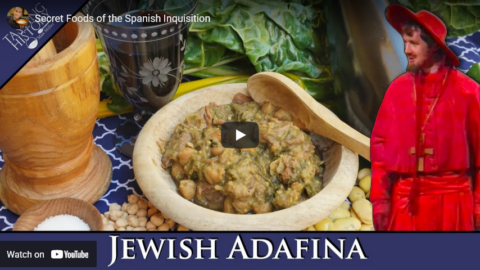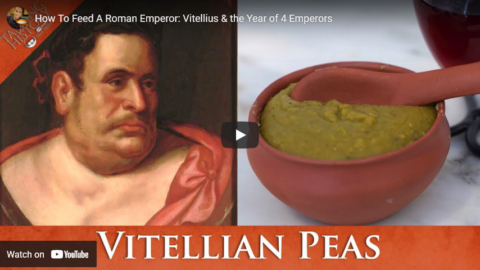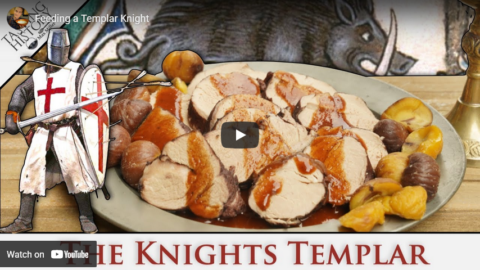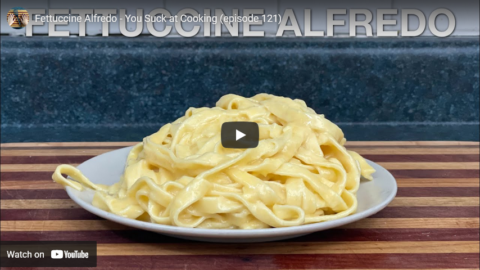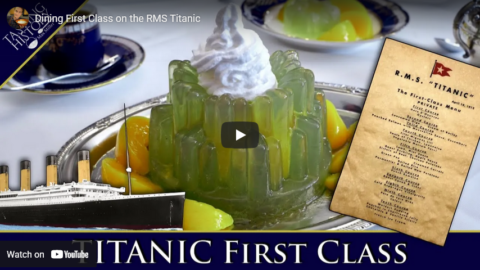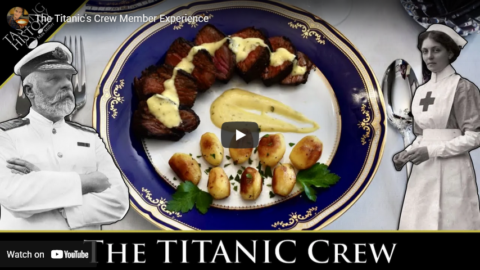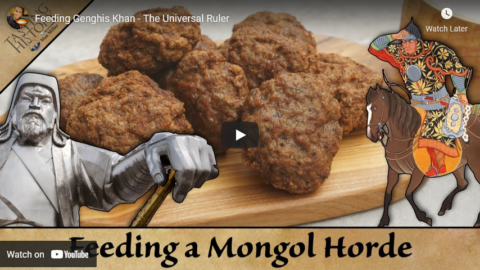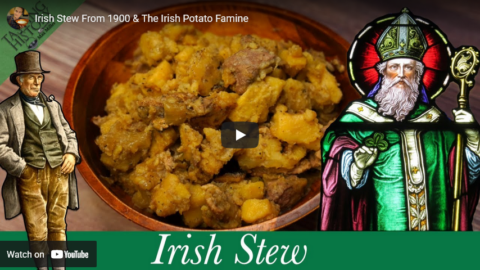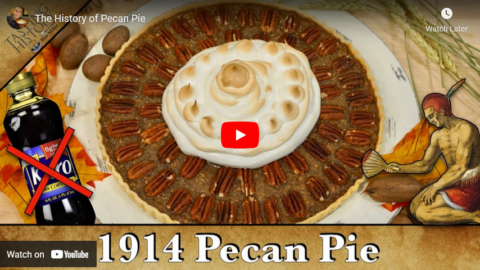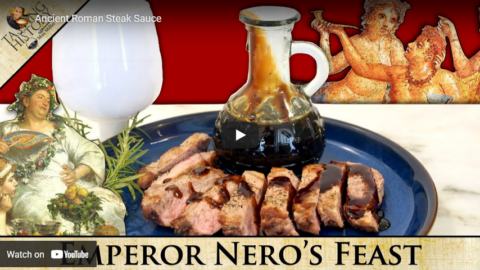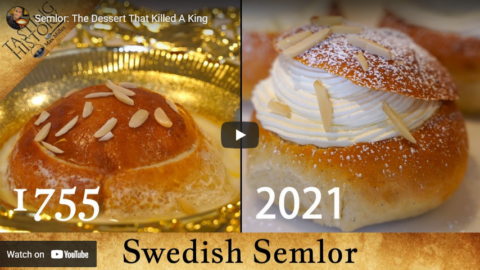Tasting History with Max Miller
Published 15 Feb 2022Support the Channel with Patreon ► https://www.patreon.com/tastinghistory
Merch ► crowdmade.com/collections/tastinghistory
Instagram ► https://www.instagram.com/tastinghist…
Twitter ► https://twitter.com/TastingHistory1
Tiktok ► TastingHistory
Reddit ► r/TastingHistory
Discord ► https://discord.gg/d7nbEpy
Amazon Wish List ► https://amzn.to/3i0mwGt
Send mail to:
Tasting History
PO Box 766
Burbank, CA 91503LINKS TO SOURCES**
A Drizzle of Honey by David M. Gitlitz and Linda Kay Davidson: https://amzn.to/3gyf0CY
The Spanish Inquisition by Henry Kamen: https://amzn.to/3B9EbVXRECIPE
1 cup (160g) dried fava beans
1 cup (180g) dried chickpeas
2 1/2 lbs or 1kg beef
¼ cup (60ml) Olive oil
1 tablespoon salt
1 large onion diced
1 quart (1L) beef broth or water
2 teaspoon ground coriander
1 1/2 tsp ground cumin
2 teaspoon ground caraway
2 teaspoon fresh ground pepper
2 Eggplant, peeled and chopped
A large handful of chard leaves1. Coat the eggplant in salt, cover, and set aside for several hours.
2. Boil the fava beans and chickpeas in a large pot for 2 minutes, then drain and set aside. In the same pot, heat half of the olive oil over medium heat then, add the onions and half of the salt and cook until lightly brown, about 8 minutes. Remove the onions and add the beef to the empty pot with the rest of the oil and salt. Cook until lightly brown, about 5 minutes. Add the onions back in as well as the beef broth/water. Bring to a simmer and cover, letting the stew simmer for 1 hour.
3. Drain and rinse the eggplant, then add it into the pot along with the fava bean, chickpeas, and spices. Cover and let cook for another 2 hours.
4. Chop the chard, then pound it flat with a rolling pin, and add it into the pot. Set the pot into the oven at 200°F and cook overnight (or at least 6 hours). Alternately, you can transfer the adafina to a slow cooker overnight. Serve alone or over rice.**Some of the links and other products that appear on this video are from companies which Tasting History will earn an affiliate commission or referral bonus. Each purchase made from these links will help to support this channel with no additional cost to you. The content in this video is accurate as of the posting date. Some of the offers mentioned may no longer be available.
Subtitles: Jose Mendoza | IG @ worldagainstjose
#tastinghistory #jewishcooking #spanishinquisition
June 16, 2022
Secret Foods of the Spanish Inquisition
May 27, 2022
How To Feed A Roman Emperor: Vitellius & the Year of 4 Emperors
Tasting History with Max Miller
Published 20 Apr 2021Help Support the Channel with Patreon: https://www.patreon.com/tastinghistory
Tasting History Merchandise: crowdmade.com/collections/tastinghistoryFollow Tasting History here:
Instagram: https://www.instagram.com/tastinghist…
Twitter: https://twitter.com/TastingHistory1
Tiktok: TastingHistory
Reddit: r/TastingHistory
Discord: https://discord.gg/d7nbEpyTasting History’s Amazon Wish List: https://amzn.to/3i0mwGt
LINKS TO INGREDIENTS & EQUIPMENT**
Sony Alpha 7C Camera: https://amzn.to/2MQbNTK
Sigma 24-70mm f/2.8 Lens: https://amzn.to/35tjyoW
Garum: https://amzn.to/3dMXnO0
Dried Marrowfat Peas: https://amzn.to/2RhIqfa
Lovage: https://amzn.to/3saQyea
Dried Ginger Root: https://amzn.to/3uFCHymLINKS TO SOURCES**
Apicius, De Re Coquinaria (translated by Elisabeth Rosenbaum and Barbara Flower): https://amzn.to/3wLqA4A
The Twelve Caesars by Suetonius: https://amzn.to/3uDUt4W
69 AD The Year of Four Emperors by Gwyn Morgan: https://amzn.to/2RfsY39**Some of the links and other products that appear on this video are from companies which Tasting History will earn an affiliate commission or referral bonus. Each purchase made from these links will help to support this channel with no additional cost to you. The content in this video is accurate as of the posting date. Some of the offers mentioned may no longer be available.
Subtitles: Jose Mendoza
PHOTO CREDITS
De Re Coquinaria: By Bonho1962 – Own work, CC BY-SA 3.0, https://commons.wikimedia.org/w/index…
Tiberius: By Carole Raddato from FRANKFURT, Germany – Tiberius, Romisch-Germanisches Museum, CologneUploaded by Marcus Cyron, CC BY-SA 2.0, https://commons.wikimedia.org/w/index…
Caligula: By Tomk2ski – Own work, CC BY-SA 4.0, https://commons.wikimedia.org/w/index…
Vomitorium: By Przemek P – https://szarada.net/okreslenie-z-krzy…, CC BY-SA 3.0, https://commons.wikimedia.org/w/index…
Amphitheatre Spectacle: Dennis Jarvis, CC BY-SA 2.0 https://creativecommons.org/licenses/…, via Wikimedia Commons
Vespasian: By Sailko – Own work, CC BY 3.0, https://commons.wikimedia.org/w/index…
Close up of the coin hoard: By Portable Antiquities Scheme from London, England – Close up of the coin hoard, CC BY-SA 2.0, https://commons.wikimedia.org/w/index…#tastinghistory #ancientrome #totalwar
May 19, 2022
Feeding a Templar Knight
Tasting History with Max Miller
Published 25 Jan 2022Support the Channel with Patreon ► https://www.patreon.com/tastinghistory
Merch ► crowdmade.com/collections/tastinghistory
Instagram ► https://www.instagram.com/tastinghist…
Twitter ► https://twitter.com/TastingHistory1
Tiktok ► TastingHistory
Reddit ► r/TastingHistory
Discord ► https://discord.gg/d7nbEpy
Amazon Wish List ► https://amzn.to/3i0mwGtSend mail to:
Tasting History
PO Box 766
Burbank, CA 91503Recipe
Boar Tenderloin
Equal parts wine and water for boiling
1 thick slice of bread without crust
1 ¼ cups white wine
¼ cup red wine
1 teaspoon ginger
2 teaspoon cinnamon
½ teaspoon nutmeg
Pinch of saffron threads
2 tablespoons brown sugar
Pinch of salt
1 tablespoon red wine vinegar (optional)1. Heat olive oil in a pot then sear the boar on all sides. Remove it from the pot and boil equal parts wine and water, then add the boar back in and boil, covered, for 10-15 minutes or until fully cooked. Then let it rest.
2. To make the sauce, mix the spices and white wine. Separately, soak the bread in water for a few hours, then pour in the red wine. Strain the bread/wine into a saucepan, then press the bread through the strainer. Add the spiced wine mixture and bring to a simmer. Let simmer for 15 minutes, or until half reduced, then add the sugar and salt, and if you with, a tablespoon of red wine vinegar. Simmer until thickened.
3. Slice the boar and pour the sauce over it. Serve with roasted chestnuts.LINKS TO SOURCES**
Le Viandier de Taillevent: https://amzn.to/3FWD7FS
Le Ménagier de Paris: https://amzn.to/3fKgyt0
The Primitive Rule of the Templars by Bernard de Clairvaux: https://amzn.to/3ItxiRY
The Templars by Dan Jones: https://amzn.to/3qOIlin**Some of the links and other products that appear on this video are from companies which Tasting History will earn an affiliate commission or referral bonus. Each purchase made from these links will help to support this channel with no additional cost to you. The content in this video is accurate as of the posting date. Some of the offers mentioned may no longer be available.
Subtitles: Jose Mendoza | IG @worldagainstjose
Music: Crusade – Video Classica by Kevin MacLeod is licensed under a Creative Commons Attribution 4.0 license. https://creativecommons.org/licenses/…
Source: http://incompetech.com/music/royalty-…
Artist: http://incompetech.com/#tastinghistory #knightstemplar
From the comments:
Tasting History with Max Miller
3 days ago
Templar should be pronounced TEM-pler, but sometimes I say tem-PLAR when I read it. Don’t do what I do
May 6, 2022
Fettuccine Alfredo – You Suck at Cooking (episode 121)
You Suck At Cooking
Published 19 Jan 2021Fettuccine Alfredo, as invented by Alfred Di Lelio in 1908, consists of pasta, butter, and parmesan. While it’s said he made it for his wife who wasn’t eating after giving birth, the truth is more likely that Mr. Alfredo had a cheese and butter addiction. While we may never know the ugly truth, we can continue to enjoy this delicious pasta dish one deadly bite at a time.
http://yousuckatcooking.com
http://instagram.com/yousuckatcooking
https://twitter.com/yousuckatcookinRecipe
.5 parts pasta to
.25 parts butter to
.25 parts parmesanCook the pasta, strengthen your wrists, and then do all the things.
The original recipe called for parmesan aged 24 months, which is a young parmesan. I used one aged 36 months so it would taste slightly wiser. Don’t even both trying to make the original noodles. It’s WAY above your pay grade.
May 2, 2022
Rome’s Wonder Medicine: Cabbage
Tasting History with Max Miller
Published 11 Jan 2022Support the Channel with Patreon ► https://www.patreon.com/tastinghistory
Merch ► crowdmade.com/collections/tastinghistory
Instagram ► https://www.instagram.com/tastinghist…
Twitter ► https://twitter.com/TastingHistory1
Tiktok ► TastingHistory
Reddit ► r/TastingHistory
Discord ► https://discord.gg/d7nbEpy
Amazon Wish List ► https://amzn.to/3i0mwGtSend mail to:
Tasting History
PO Box 766
Burbank, CA 91503LINKS TO INGREDIENTS & EQUIPMENT**
Sony Alpha 7C Camera: https://amzn.to/2MQbNTK
Sigma 24-70mm f/2.8 Lens: https://amzn.to/35tjyoW
Garum: https://amzn.to/32NZX52LINKS TO SOURCES**
De re coquinaria by Apicius: https://amzn.to/3eZYElG
De Agricultura by Cato the Elder: https://amzn.to/3eZZ4IM
The Natural History by Pliny the Elder: https://amzn.to/3FeOIzL**Some of the links and other products that appear on this video are from companies which Tasting History will earn an affiliate commission or referral bonus. Each purchase made from these links will help to support this channel with no additional cost to you. The content in this video is accurate as of the posting date. Some of the offers mentioned may no longer be available.
Subtitles: Jose Mendoza | IG @ worldagainstjose
PHOTO
By Bonho1962 – Own work, CC BY-SA 3.0, https://commons.wikimedia.org/w/index…
Psuedo-Galen Anatomy: CC BY 4.0 https://creativecommons.org/licenses/…, via Wikimedia Commons#tastinghistory #ancientrome
April 17, 2022
Queen Victoria’s Easter Cake
Tasting History with Max Miller
Published 23 Mar 2021Help Support the Channel with Patreon: https://www.patreon.com/tastinghistory
Tasting History Merchandise: crowdmade.com/collections/tastinghistoryFollow Tasting History here:
Instagram: https://www.instagram.com/tastinghist…
Twitter: https://twitter.com/TastingHistory1
Tiktok: TastingHistory
Reddit: r/TastingHistory
Discord: https://discord.gg/d7nbEpyLINKS TO INGREDIENTS & EQUIPMENT**
Sony Alpha 7C Camera: https://amzn.to/2MQbNTK
Sigma 24-70mm f/2.8 Lens: https://amzn.to/35tjyoW
Self Rising Flour: https://amzn.to/3cKxIoy
Almond Flour: https://amzn.to/3cGN9Ox
Mixed Peel: https://amzn.to/3lp6MP2
Currants: https://amzn.to/3bWEXe4
Castor Sugar: https://amzn.to/3vJMjJR
8 Inch Cake Pan: https://amzn.to/3f3fL7JLINKS TO SOURCES**
Pot Luck: British Home Cookery Book by May Byron: https://amzn.to/3r1qQIp
The Chronicle of Battle Abbey: https://amzn.to/3ePfrco
Cake: A Slice of History by Alysa Levene: https://amzn.to/2Q7JOAs**Some of the links and other products that appear on this video are from companies which Tasting History will earn an affiliate commission or referral bonus. Each purchase made from these links will help to support this channel with no additional cost to you. The content in this video is accurate as of the posting date. Some of the offers mentioned may no longer be available.
Subtitles: Jose Mendoza
#tastinghistory #easter #simnelcake
April 14, 2022
Dining First Class on the RMS Titanic
Tasting History with Max Miller
Published 12 Apr 2022Signup for your FREE trial to Wondrium here: http://ow.ly/rSyS30sfmaG
Support the Channel with Patreon ► https://www.patreon.com/tastinghistory
Merch ► crowdmade.com/collections/tastinghistory
Instagram ► https://www.instagram.com/tastinghist…
Twitter ► https://twitter.com/TastingHistory1
Tiktok ► TastingHistory
Reddit ► https://www.reddit.com/r/TastingHistory/
Discord ► https://discord.gg/d7nbEpy
Amazon Wish List ► https://amzn.to/3i0mwGtSend mail to:
Tasting History
PO Box 766
Burbank, CA 91503LINKS TO INGREDIENTS & EQUIPMENT**
Sony Alpha 7C Camera: https://amzn.to/2MQbNTK
Sigma 24-70mm f/2.8 Lens: https://amzn.to/35tjyoW
Green Chartreuse: https://bit.ly/onlinebottlesmax
Leaf Gelatin: https://amzn.to/3NY6Y5SLINKS TO SOURCES**
Last Dinner on the Titanic by Rick Archbold and Dana McCauley: https://amzn.to/3tqNz5s
Titanic, First Accounts: https://amzn.to/3L2f7UH
The Sinking of the Titanic: 1912 Survivor Accounts by Bruce M. Caplan and Logan Marshall: https://amzn.to/3KSKock
The 10 Best Titanic Survivor Stories: https://amzn.to/3wioSK3RECIPE
Ingredients:
16 sheets Gelatin (or 4 envelopes of powdered gelatin)
3 cups (750ml) Water
1/2 cup (50g) Sugar
1 cup (250ml) Chartreuse
2-4 ripe Peaches or a large can of peaches in syrup
1 cup (250ml) Simple syrup (not necessary if using canned peaches1. Soak the gelatin in cold water for 5 minutes.
2. Bring the water and sugar to a simmer in a large saucepan then remove it from the heat. Squeeze out any excess water in the gelatin, then add it to the water and stir until dissolved. Stir in the Chartreuse.
3. Pour the liquid into a well greased mold, then refrigerate for 1-3 hours, or until the jelly is beginning to thicken.
4. To remove the skin from the peaches, score and X at the bottom of the peaches, then plunge into boiling water for 45 seconds, then immediately into ice cold water for 10 seconds. If the peaches are ripe, the skin should easily slide off. Remove the pit and slice.
5. Heat the simple syrup to simmering, then add the peach slices. Coat and turn off the heat and let them cool in the syrup.
6. Carefully insert the peaches into the jelly in whatever pattern you like. Then return to the refrigerator until fully set. 8 – 24 hours depending on the depth of the mold.
7. Once set, run a knife around the edge of the jelly, then dip the mold into hot (not boiling) water for 5 seconds. Remove it and place a well greased plate over the top of the mold then flip it over. The jelly should fall out with little more than a tap.
8. Top with Italian meringue or whipped cream, and serve.**Some of the links and other products that appear on this video are from companies which Tasting History will earn an affiliate commission or referral bonus. Each purchase made from these links will help to support this channel with no additional cost to you. The content in this video is accurate as of the posting date. Some of the offers mentioned may no longer be available.
Subtitles: Jose Mendoza | IG @worldagainstjose
#tastinghistory #titanic #firstclass
April 7, 2022
The Titanic‘s Crew Member Experience
Tasting History with Max Miller
Published 5 Apr 2022Use code TASTINGHISTORY16 for up to 16 FREE MEALS + 3 Surprise Gifts across 6 HelloFresh boxes plus free shipping at https://bit.ly/32fHZYT
Support the Channel with Patreon ► https://www.patreon.com/tastinghistory
Merch ► crowdmade.com/collections/tastinghistory
Instagram ► https://www.instagram.com/tastinghist…
Twitter ► https://twitter.com/TastingHistory1
Tiktok ► TastingHistory
Reddit ► https://www.reddit.com/r/TastingHistory/
Discord ► https://discord.gg/d7nbEpy
Amazon Wish List ► https://amzn.to/3i0mwGtSend mail to:
Tasting History
PO Box 766
Burbank, CA 91503LINKS TO INGREDIENTS & EQUIPMENT**
Sony Alpha 7C Camera: https://amzn.to/2MQbNTK
Sigma 24-70mm f/2.8 Lens: https://amzn.to/35tjyoW
Brown Stock: https://amzn.to/3K4Prq8
Tarragon Vinegar: https://amzn.to/3iV2HBNLINKS TO SOURCES**
Guide to the Crew of Titanic by Günter Bäbler: https://amzn.to/3IUiYS8
Last Dinner on the Titanic: https://amzn.to/3u8M6RH
The Last Night on the Titanic by Veronica Hinke: https://amzn.to/3qUH5tPRECIPE
Sirloin Steak
1lb small golden potatoes
2 tablespoons clarified butter
Brown Stock: https://amzn.to/3K4Prq8
(100ml) White wine
(100ml) Tarragon Vinegar: https://amzn.to/3iV2HBN
2 tablespoons chopped Shallots
1 cup (15g) tarragon leaves, roughly chopped
2 teaspoons (2.5g) Whole Peppercorns, roughly pounded
Pinch of Salt
3 large Egg yolks
2 ¼ sticks (250g) Butter
3/4 tablespoon finely chopped tarragon
Pinch of CayenneSlowly reduce the brown stock until it coats the back of a spoon.
Wash then carve the potatoes into small olive shapes. Melt the clarified butter with a little salt and pepper then, over a very low heat, add the potatoes and cook until golden brown.
Prepare the Béarnaise sauce using Escoffier’s recipe below. I have cut the ingredients in half and still had more than 2 cups of sauce.
Escoffier’s Béarnaise:
Sauce Béarnaise
“Place 2 dl each of white wine and tarragon vinegar in a small pan with 4 tbs chopped shallots, 20g chopped tarragon leaves, 10g chopped chervil, 5g crushed peppercorns and a pinch of salt. Reduce by two thirds and allow to cool.
“Add 6 egg yolks to the reduction and prepare the sauce over a gentle heat by whisking in 500g of ordinary or melted butter. The cohesion and emulsification of the sauce is effected by the progressive cooking of the egg yolks which depends to a great extent on its preparation over a slow heat.
“When the butter has been completely incorporated, pass the sauce through a fine strainer; correct the seasoning, add a little Cayenne and finish by mixing in 1 tbs chopped tarragon and ½ tbs chopped chervil.”**Some of the links and other products that appear on this video are from companies which Tasting History will earn an affiliate commission or referral bonus. Each purchase made from these links will help to support this channel with no additional cost to you. The content in this video is accurate as of the posting date. Some of the offers mentioned may no longer be available.
Subtitles: Jose Mendoza | IG @ worldagainstjose
#tastinghistory #titanic
March 23, 2022
What did Genghis Khan eat?
Tasting History with Max Miller
Published 30 Nov 2021Support the Channel with Patreon ► https://www.patreon.com/tastinghistory
Merch ► crowdmade.com/collections/tastinghistory
Instagram ► https://www.instagram.com/tastinghist…
Twitter ► https://twitter.com/TastingHistory1
Tiktok ► TastingHistory
Reddit ► r/TastingHistory
Discord ► https://discord.gg/d7nbEpy
Amazon Wish List ► https://amzn.to/3i0mwGtSend mail to:
Tasting History
PO Box 766
Burbank, CA 91503LINKS TO INGREDIENTS & EQUIPMENT**
Sony Alpha 7C Camera: https://amzn.to/2MQbNTK
Sigma 24-70mm f/2.8 Lens: https://amzn.to/35tjyoW
Asafoetida: https://amzn.to/3DKCH4P
Long Pepper: https://amzn.to/2ZgFRhYLINKS TO SOURCES**
Soup for the Qan: https://amzn.to/3oXOpDk
Description of the World by Marco Polo: https://amzn.to/3xf5093
Genghis Khan and the Making of the Modern World: https://amzn.to/32fDmxm**Some of the links and other products that appear on this video are from companies which Tasting History will earn an affiliate commission or referral bonus. Each purchase made from these links will help to support this channel with no additional cost to you. The content in this video is accurate as of the posting date. Some of the offers mentioned may no longer be available.
Subtitles: Jose Mendoza | IG @ worldagainstjose
PHOTO CREDITS
Stones pressing curd: Taylor Weidman / The Vanishing Cultures Project#tastinghistory #genghiskhan
March 17, 2022
Irish Stew From 1900 & The Irish Potato Famine
Tasting History with Max Miller
Published 16 Mar 2021Help Support the Channel with Patreon: https://www.patreon.com/tastinghistory
Tasting History Merchandise: crowdmade.com/collections/tastinghistoryFollow Tasting History here:
Instagram: https://www.instagram.com/tastinghist…
Twitter: https://twitter.com/TastingHistory1
Tiktok: TastingHistory
Reddit: r/TastingHistory
Discord: https://discord.gg/d7nbEpyLINKS TO INGREDIENTS & EQUIPMENT**
Sony Alpha 7C Camera: https://amzn.to/2MQbNTK
Sigma 24-70mm f/2.8 Lens: https://amzn.to/35tjyoW
Le Creuset Cast Iron Round Casserole: https://amzn.to/2N5rTJKLINKS TO SOURCES**
Tamales Video: https://www.youtube.com/watch?v=s2JyN…
Quesadilla Video: https://www.youtube.com/watch?v=NPxjQ…
The History of the Great Irish Famine of 1847 by John O’Rourke: https://amzn.to/3qCM8fD
Great Irish Potato Famine: https://amzn.to/3kZg58j**Some of the links and other products that appear on this video are from companies which Tasting History will earn an affiliate commission or referral bonus. Each purchase made from these links will help to support this channel with no additional cost to you. The content in this video is accurate as of the posting date. Some of the offers mentioned may no longer be available.
Subtitles: Jose Mendoza
PHOTO CREDITS
Saint Patrick Catholic Church: By Nheyob – Own work, CC BY-SA 4.0, https://commons.wikimedia.org/w/index…
Kindred Spirits: By Gavin Sheridan – Own work, CC BY-SA 4.0, https://commons.wikimedia.org/w/index…MUSIC CREDITS
“Fiddles McGinty” by Kevin MacLeod is licensed under a Creative Commons Attribution 4.0 license. https://creativecommons.org/licenses/…
Source: http://incompetech.com/music/royalty-…
Artist: http://incompetech.com/“Achaidh Cheide – Celtic” by Kevin MacLeod is licensed under a Creative Commons Attribution 4.0 license. https://creativecommons.org/licenses/…
Source: http://incompetech.com/music/royalty-…
Artist: http://incompetech.com/#tastinghistory #stpatricksday #ireland
March 15, 2022
QotD: Pecan pie
The pecan pie is the highest expression of the pie-making art, and it is uncomfortable when well-meaning people tout silly and pale reflections of pie as somehow superior.
I won’t even discuss the lowly pumpkin pie, which reminds me of nothing more than the goo that seeps out of a broken sewage pipe or the remains of the vegetable bin after a 10-day blackout.
You apple pie people may have a point, but really, the best part of any apple pie is the crust, so just climb down off that high horse!
Blueberry you say? Yes, I will grant the glory of a well-made blueberry pie, but on the second day it is a soggy mess, while my pecan pie is a wonderful accompaniment to a great cup of coffee. And bacon. But that doesn’t even have to be said.
Key lime and Boston cream and … um … other pies are certainly good eating, but for sheer pie power and authority there is nothing quite like American pecan pie served after a sumptuous Thanksgiving dinner.
[Here’s my go-to recipe … probably from Cooks Illustrated, but I don’t remember]
CBD, “Food Thread: Family, Friends And Pecan Pie … But Mostly Pecan Pie … And Family And Friends!”, Ace of Spades H.Q., 2021-11-21.
February 28, 2022
The History of Pecan Pie
Tasting History with Max Miller
Published 16 Nov 2021Support the Channel with Patreon ► https://www.patreon.com/tastinghistory
Merch ► crowdmade.com/collections/tastinghistory
Instagram ► https://www.instagram.com/tastinghist…
Twitter ► https://twitter.com/TastingHistory1
Tiktok ► TastingHistory
Reddit ► r/TastingHistory
Discord ► https://discord.gg/d7nbEpy
Amazon Wish List ► https://amzn.to/3i0mwGtSend mail to:
Tasting History
PO Box 766
Burbank, CA 91503SOURCES**
The Pecan: A History of America’s Native Nut by James McWilliams: https://amzn.to/3mQ2JxJ
Antoine of Oak Alley by Katy Morlas Shannon: https://amzn.to/3kf6sTG**Some of the links and other products that appear on this video are from companies which Tasting History will earn an affiliate commission or referral bonus. Each purchase made from these links will help to support this channel with no additional cost to you. The content in this video is accurate as of the posting date. Some of the offers mentioned may no longer be available.
Subtitles: Jose Mendoza | IG @ worldagainstjose | @Ketchup with Max and Jose
PHOTO CREDITS
Dickey’s BBQ Pecan Pie: Willis Lam, CC BY-SA 2.0 https://creativecommons.org/licenses/…, via Wikimedia Commons
Pecan Tree: By Bruce Marlin – Own work: http://www.cirrusimage.com/tree_pecan…, CC BY 3.0, https://commons.wikimedia.org/w/index…
Oak Alley Plantation: Michael McCarthy via flickr, https://creativecommons.org/licenses/…#tastinghistory #pecanpie #thanksgiving
February 20, 2022
Ancient Roman Steak Sauce
Tasting History with Max Miller
Published 9 Nov 2021Support the Channel with Patreon ► https://www.patreon.com/tastinghistory
Merch ► crowdmade.com/collections/tastinghistory
Instagram ► https://www.instagram.com/tastinghist…
Twitter ► https://twitter.com/TastingHistory1
Tiktok ► TastingHistory
Reddit ► r/TastingHistory
Discord ► https://discord.gg/d7nbEpySend mail to:
Tasting History
PO Box 766
Burbank, CA 91503LINKS TO INGREDIENTS & EQUIPMENT**
Sony Alpha 7C Camera: https://amzn.to/2MQbNTK
Sigma 24-70mm f/2.8 Lens: https://amzn.to/35tjyoW
Flor de Garum: https://amzn.to/3EEXs27
Saba: https://amzn.to/3EHnz8G
Long Pepper: https://amzn.to/3EK3oqq
Juniper Berries: https://amzn.to/3GLB8FPLINKS TO SOURCES**
De re coquinaria (Apicius): https://amzn.to/3BIidI8
A Taste of Ancient Rome by Ilaria Giacosa: https://amzn.to/3nZ7PqV**Some of the links and other products that appear on this video are from companies which Tasting History will earn an affiliate commission or referral bonus. Each purchase made from these links will help to support this channel with no additional cost to you. The content in this video is accurate as of the posting date. Some of the offers mentioned may no longer be available.
Subtitles: Jose Mendoza – IG @worldagainstjose
PHOTO CREDITS
Apicius: By Bonho1962 – Own work, CC BY-SA 3.0, https://commons.wikimedia.org/w/index…
Domitian: By I, Sailko, CC BY 2.5, https://commons.wikimedia.org/w/index…
Cartwright, Mark. “Mushrooms, Roman Mosaic.” World History Encyclopedia, 23 Jan 2016. Web. 01 Nov 2021.
Agrippina crowning her young son Nero: By Carlos Delgado, CC BY-SA 3.0, https://commons.wikimedia.org/w/index…#tastinghistory
February 8, 2022
Semlor: The Dessert That Killed A King
Tasting History with Max Miller
Published 16 Feb 2021For information on Svensk Hyllningsfest in Lindsborg, KS, visit https://www.visitlindsborg.com/
Help Support the Channel with Patreon: https://www.patreon.com/tastinghistory
Tasting History Merchandise: crowdmade.com/collections/tastinghistoryFollow Tasting History here:
Instagram: https://www.instagram.com/tastinghist…
Twitter: https://twitter.com/TastingHistory1
Tiktok: TastingHistory
Reddit: r/TastingHistory
Discord: https://discord.gg/d7nbEpyLINKS TO INGREDIENTS & EQUIPMENT**
Sony Alpha 7C Camera: https://amzn.to/2MQbNTK
Sigma 24-70mm f/2.8 Lens: https://amzn.to/35tjyoW
Silpat: https://amzn.to/3rFIFxM
KitchenAid 8-Quart Stand Mixer: https://amzn.to/3cTfbs1LINKS TO SOURCES**
Hjelpreda I Hushållningen För Unga Fruentimber by Cajsa Warg: https://gupea.ub.gu.se/handle/2077/41…
A Journey Through Swedish history by Herman Lindqvist: https://amzn.to/2Z0D3Sb
The world of Cajsa Andersdotter by Bengt Hällgren: https://amzn.to/3jKNMKl**Amazon offers a small commission on products sold through their affiliate links, so each purchase made from this link, whether this product or another, will help to support this channel with no additional cost to you.
Subtitles: Jose Mendoza
#tastinghistory #semlor #semla #fattuesday
February 7, 2022
American pizza
At An Eccentric Culinary History, H.D. Miller makes a strong case for pizza being more an American dish than an Italian one:
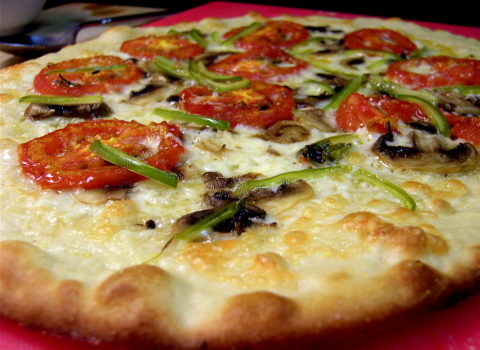
“Pizza” by rdpeyton
Today, standing atop the sprawling edifice that is the American restaurant industry, it’s hard to imagine a time when pizza wasn’t popular. But, prior to World War Two, pizza was barely known in the United States outside of a few Italian enclaves in the Northeast. For all of the praise heaped upon Lombardi’s in New York City, until the war, few people north of Houston Street had heard of it, or the dish it served.
From the mid-19th century forward, there were plenty of Italians in America, in places like New York, New Orleans and San Francisco. Most of those early Italian immigrants — around 75,000 before 1880 — were from northern Italy, not the South, and the restaurants they built were usually serving multi-course, table d’hôte meals of meat, bread, macaroni, wine and coffee at reasonable prices. The model was Caffe Moretti’s in Manhattan. Established in 1858 by Stefano Morretti, an ex-seminarian from the Veneto, Morretti’s offered diners generous portions and cheap prices. It did not, however, offer pizzas.
I have to emphasize this, you couldn’t order a pizza in the vast majority of Italian restaurants in America prior to 1945. And the reason you couldn’t order a pizza in Italian restaurants is because pizza isn’t Italian.
Let me repeat that: Pizza isn’t Italian.
Pizza is Neapolitan. It’s a distinct speciality of Naples, developed at at time when Italy didn’t even exist as a nation. Saying pizza is Italian is like saying haggis is British. It might be technically true, but not really.
As in America, prior to the 1950’s, pizza wasn’t something most Italians knew or cared about. In 1900, there were supposedly no pizzerias in Italy anywhere outside of the medieval walls of Napoli. You couldn’t even get pizza in the suburbs. Pizza was strictly street food for poor people in the crowded tangled alleys near the port. […]
In other words, pizza was not something the average Tuscan, Ligurian or Venetian would have thought suitable for a sit-down meal. Or, if they ever did think of it, it was to revile pizza as oily, unappetizing and a likely vector of cholera. This is because Naples was really famous at the time for being dirty and disease-ridden. (If you’re serious about early pizza history, one that strips away the just-so stories, then go read Inventing the Pizzeria by Antonio Mattozzi.)
What brought pizza to America was the mass immigration of southern Italians between 1880 and 1910, when more than 4 million people moved to the United States. That’s why Lombardi’s didn’t get going until 1905, when there were finally enough Neapolitans in Little Italy to keep the doors open.
The same dynamic played out in South America, in Argentina, Uruguay and Brazil. The first successful pizza restaurant in the world located outside of Naples was founded in Buenos Aires in 1882, when a Neapolitan immigrant baker named Nicolas Vaccarezza started selling the pies out of his shop in Boca. For reference purposes, a decade earlier, an attempt to open a pizzeria in Rome, Italy, had ended in bankruptcy, meaning, at the turn of the last century, you could get a pizza in Buenos Aries, São Paulo or New York, but not in Rome, Florence or Venice.
H/T to Ed Driscoll for the link.

